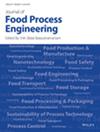Freezing Characteristics of Beef Chunks by Air Blast Freezing Under Different Conditions
Abstract
In order to achieve energy-saving in fast freezing equipment, it is necessary to understand the factors that affect food freezing time. A fluid structure coupling model was established for the freezing process of beef in a freezing room. A total of 45 simulation areas were set with 9 racks and 5 beef chunks on each rack. In the model, the specific heat capacity of the packages was defined as a function of temperature. The core temperatures of the frozen load chunks instead of real beef were measured to verify the correctness of the model. The airflow velocity, air temperature and frozen product temperatures were simulated at different frozen product positions, fan outlet velocities and temperatures. The freezing rates, local Reynolds numbers and wall adjacent heat transfer coefficients were obtained for the chunks. The result shows that the uneven distribution of airflow velocity directly leads to differences in the freezing and heat transfer characteristics of each frozen product. A large vortex with lower airflow velocity and higher airflow temperature in the middle area of the quick-freezing room causes a slower freezing rate of frozen products. The highest freezing rate is 1.67 cm/h among 45 chunks, and most chunks have a freezing rate greater than 1 cm/h. The variations of the freezing rates are basically consistent with the local wall adjacent heat transfer coefficients within the range of 17.8 to 52.2 W/m2 K. The findings of this article can help provide the appropriate freezing parameters, elucidate the freezing characteristics of beef and offer optimization suggestions for the freezing process of fast freezing rooms.


 求助内容:
求助内容: 应助结果提醒方式:
应助结果提醒方式:


